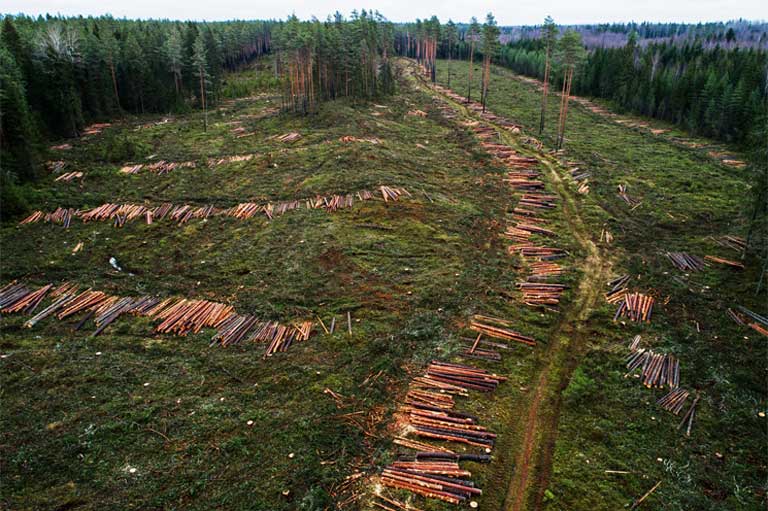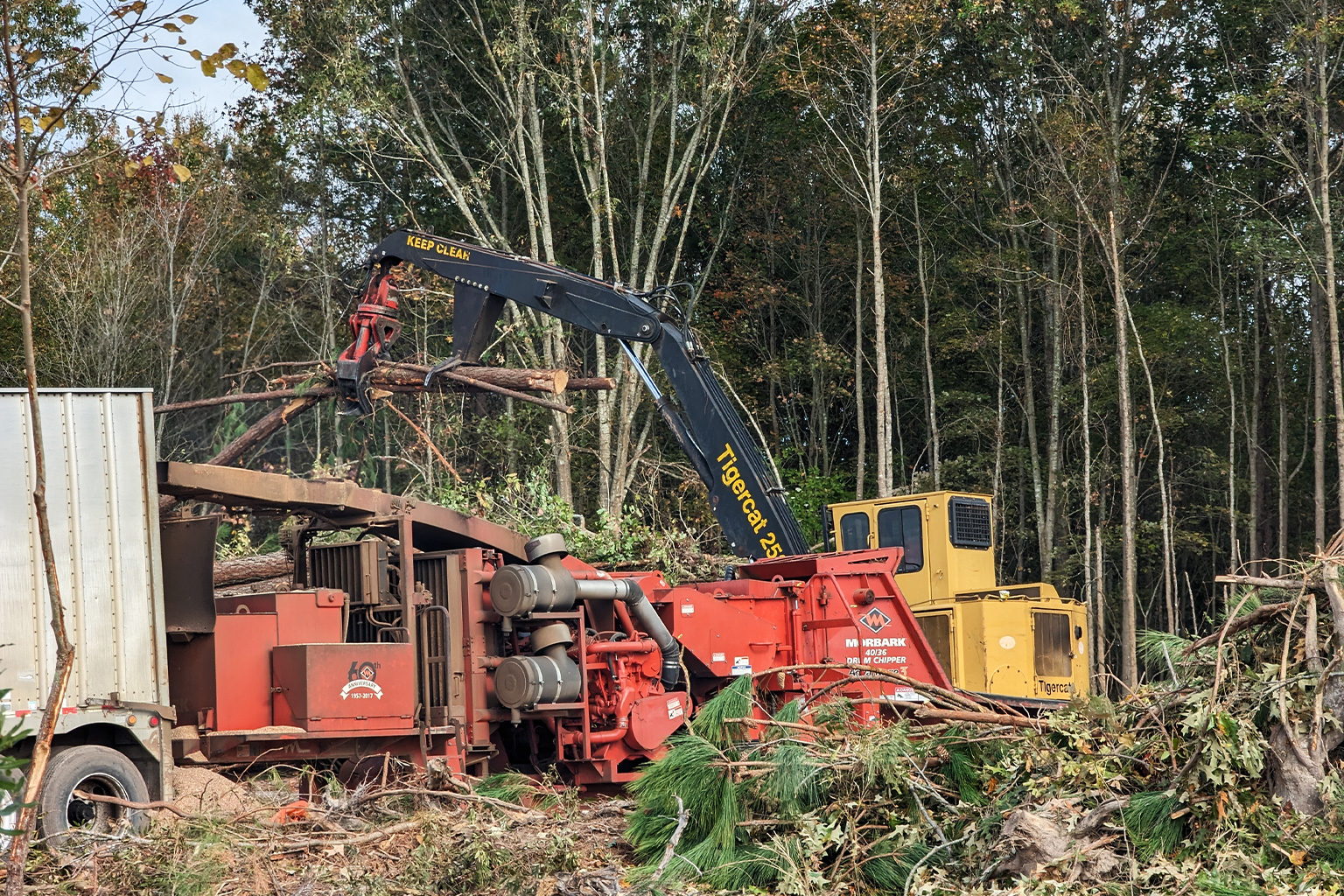- The final revisions to the European Union’s Renewable Energy Directive (RED) were reached March 30, with nearly all environmental activists (who had lobbied intensely for changes for years), responding negatively to RED policies in support of forest biomass.
- The policy revisions will continue allowing the burning of the world’s forests to make energy, with emissions from EU powerplant smokestacks not counted. Wood pellets will still be classified as renewable energy on par with zero-carbon wind and solar, even though biomass releases more CO2 than coal, per unit of energy produced.
- While most forest advocates agree that the RED revisions made some small concessions to the environment, they say the biomass regulations include gaping loopholes that will allow the EU to heavily subsidize wood pellets made from trees harvested in Europe, the U.S. and Canada.
- Enviva, the world’s largest wood pellet producer, wrote that it “welcomes [the] REDIII agreement and continued recognition of biomass as 100% renewable.” Forest advocates say they will now shift their campaign strategy against biomass burning from focusing on the EU as a whole to efforts made in individual European nations.
Forest campaigners voiced grave disappointment and alarm March 30 over the European Union’s Renewable Energy Directive (RED) as it applies to wood burning for energy and heat. Nearly all agree that the new biomass policy will further damage global forests, increase heat-trapping carbon emissions, and exacerbate climate change, even as policymakers claim the approved regulations do the opposite.
“The revised RED is not based on advancing scientific or even pragmatic insights as we fought and hoped for years,” Fenna Swart, a forest advocate with The Netherlands’ Clean Air Committee, told Mongabay. “It is only a political solution for key stakeholders… for an unsolved global problem.” Stakeholders who benefit, she said, include northern European member states with large harvestable forests such as Sweden and Finland, and the forestry and energy industries.
Campaigners did note that some additional forest and soil protections are now a part of the third iteration of RED. For example, REDIII prohibits biomass subsidies in the 27-member states for “harvested roundwood” better suited for higher value timber products. It also bans biomass subsidies supporting the use of stumps and roots, which when left in the ground protect soil sequestered carbon.
The major problem, say activists, is that REDIII keeps intact the definition of woody biomass as a renewable energy source on par with zero-carbon wind and solar — a definition Australia chose to abandon last December to stave off biomass industry incursions there.

EU NGOs and environmental scientists spent years building their case to the public and policymakers for major changes to RED regarding forest biomass. Specifically, they lobbied hard for a definition change and elimination of taxpayer subsidies for wood burning.
But the EU REDIII biomass provisions ensure that forests in Eastern Europe and Scandinavia, the Southeastern U.S. and British Columbia, Canada, will continue to be cut for the manufacture of wood pellets to be burned to produce heat and energy — making contributions to deforestation that can still be subsidized by EU nations.
And because biomass continues to be defined by policy as carbon neutral, smokestack emissions will still go uncounted as if they don’t exist, even though research shows that “biomass burning power plants emit 150% the CO2 of coal, and 300 – 400% the CO2 of natural gas, per unit energy produced.”
This means that while coal burning will be phased out, large-scale carbon emissions will still flow from EU power plants for years to come, despite last month’s report by the UN Intergovernmental Panel on Climate Change (IPCC) which warns that without immediate and dramatic greenhouse gas emission reductions, there is little chance of achieving the Paris Agreement goal of holding global temperature rise to 1.5 degree Celsius (2.7 degrees F) above pre-industrial levels, thus staving off potentially catastrophic climate impacts in the next 10 to 15 years.
“This EU decision is a recipe for emissions increases in the vital period for emissions reductions because it leaves the way open for further unrestrained increases in burning forest wood,” said Peg Putt, with the Forests, Climate and Biomass Working Group of the Environmental Paper Network. “It’s not an effective way to combat climate change. To do that, we simply have to go beyond burning both wood and fossil fuels.”

Added incentive to increase wood burning?
One revision to REDIII calls for EU renewable energy to increase from 30% to 42.5% of total energy production by 2030 with all member states required to contribute to the increase, a decision heralded by policymakers as significant climate progress.
“We will not only increase the share of renewables to 42.5% but also substantially fasten authorization and permit-granting processes for renewable energy facilities,” Markus Pieper, a German conservative lawmaker who led the European Parliament’s delegation in the final negotiations, told Euractiv, a Brussels news agency. “This is a good day for Europe’s energy transition.”
But Almuth Ernsting with the NGO Biofuelwatch in the U.K, offered a different assessment, given the continued ability of countries to claim wood-burning as renewable energy:
“This EU decision is one to sacrifice forests and climate for the sake of meeting renewable energy targets, even though such targets only make sense if they actually benefit the climate,” she said. “Member states can, if they wish, support further large-scale expansion of forest biomass burning to help meet this [renewable energy] increase, even though the climate impacts of forest biomass [burning] are no less than those from burning coal.”
In what is considered a hopeful development by environmentalists, REDIII continues a past provision that individual EU members states “may establish additional sustainability criteria for biomass fuels” beyond what the revised directive stipulates.
National limits on biomass are already happening. For example, the Netherlands last December, passed a law (based in part on exclusive Mongabay reporting) that prohibits subsidizing the purchase of wood pellets that have contributed to deforestation in Europe or abroad, and requires a higher level of scrutiny of wood pellet sourcing.
Also, Slovakia and Portugal added laws that only allow government subsidies for wood pellets made from forest and lumber mill residues, banning the use of whole trees from native forests.
Rita Frost, a forest campaigner with the Dogwood Alliance, a North Carolina NGO, said advocacy efforts will now likely increasingly focus on individual EU countries inclined to reduce or eliminate woody biomass consumption and/or subsidies. Germany, The Netherlands and Belgium, all large biomass consumers, are seen as initial targets.

Biomass industry applauds REDIII
The forest biomass industry hailed the approval of the EU revisions, with Enviva, the world’s largest wood pellet producer, writing that it “welcomes [the] REDIII agreement and continued recognition of biomass as 100% renewable.”
Christian Rakos, president of the World Bioenergy Association in Stockholm, told Mongabay that REDIII is a step forward for the climate and forests. He was alarmed by last month’s IPCC report, adding, “I find it more urgent than ever to reach a fact-based consensus on the role bioenergy can play to mitigate climate change.”
In Rakos’ view, NGOs saw many of their demands met in the RED final revision: no subsidies for high-value roundwood, references to sustainable forestry practices, respect for biodiversity and high greenhouse gas reduction targets.
“This ensures that sustainability will be respected as a precondition of using bioenergy,” Rakos explained. “While we may have different opinions on whether these requirements have been met in the past, I feel confident that the strict legal requirements that will now be implemented will form the base of a consensus of how bioenergy can contribute to a sustainable energy system.”

However, where Rakos sees enhanced regulation, NGOs see the same policy loopholes that have enabled wood-pellet production to grow unimpeded into a multibillion-dollar industry in just over a decade. Wood burning accounts for 60% of what’s labeled as renewable energy generation in the EU.
“This decision is no different from what the EU has been putting out as biomass policy over the last 15 years,” Frost at Dogwood said, “some fancy words that shift the emphasis, but take no real action.”
Rakos’ view of forests differs dramatically and fundamentally from the NGO position. Like most forestry advocates, he believes that foresters (by cutting, culling and replanting) manage forests better than nature — a contention science disputes though this remains an area of controversy. He also stresses that 87% of European biomass comes from residues not native forests, a contention challenged by NGO documentation and independent reporting.
“There is evidence that forests are increasingly affected by climate change,” Rakos said. “In Europe, large areas of forests — particularly softwood forests — will not survive ever hotter and dryer weather. The only way to preserve these forests as forests is to change monocultures of softwoods to mixed forests that are more drought resistant.
“This means harvest more, use the wood as far as possible for building materials, and replace spruce at least partly with deciduous trees. This will increase biodiversity, improve resilience of forests and produce more residues to replace fossil fuel energy.”
Putting this argument in perspective, it’s important to note that a growing share of EU wood pellets are imported from outside Europe.

Could REDIII have some teeth?
While most NGOs reject the industry’s managed forests philosophy as a cover for increased deforestation to boost profits, at least one forest campaigner’s analysis of REDIII found more to applaud than criticize.
Scientist Mary Booth is a long-time woody biomass expert and director of the U.S-based Partnership for Policy Integrity. She issued a release noting that REDIII “eliminates subsidies for energy generated by burning certain categories of forest wood [and] ends direct financial support for electricity generated by burning wood from primary and old-growth forests from counting toward renewable energy targets.”
She also noted that while REDIII ignored a proposal “to directly reduce the amount of energy from forest biomass that counts toward the EU’s renewable energy targets, [it] greenlighted new rules requiring EU countries to assess whether biomass use is compatible with climate goals.”
Where other NGOs see such REDIII provisions as weak or difficult to enforce, Booth sees them as setting the stage to pressure certain EU member states to go further to “restrict the use of forest wood for fuel.”
“Requiring [EU] member states to assess how logging forests is undermining their ability to reduce emissions spells the end of the fantasy that biomass energy is carbon neutral,” Booth wrote, “and the first steps toward a rational, science-based renewable energy policy.”
Banner image: Logged trees for biomass in Bischofsheim, Germany. Image by 7C0 via Flickr (CC BY 2.0).
Justin Catanoso, a regular Mongabay contributor, is a professor of journalism at Wake Forest University in North Carolina.
Japan, EU & UK biomass emissions standards fall short and are full of loopholes, critics say
FEEDBACK: Use this form to send a message to the author of this post. If you want to post a public comment, you can do that at the bottom of the page.














